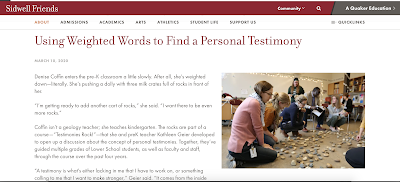https://www.sidwell.edu/about/news/news-detail/~board/homepage-news-panel/post/using-weighted-words-to-find-a-personal-testimony
Come join us for Testimonies Rock!
*Note: We credit Jessica Beels' installation of Weigh Your Words with inspiring this course. After Kathleen and I experienced this powerful art exhibit, we were drawn to the idea of creating an interactive experience with the Quaker Testimonies and something of the earth - seashells, rocks, branches... We eventually found that rocks were the best suited for our course. You can read more about Beels' exhibit here: http://www.jbeelsdesign.com/blog/?p=160
Text of article from Sidwell Friends School Website:
Using Weighted Words to Find a Personal Testimony
MARCH 10, 2020

“I think testimonies are one of the big tentpoles of Quakerism at a Quaker school,” Coffin said. “It’s listening to that still, small voice and looking at how you travel through this world constantly making yourself and the world a better place. As a Quaker school, there are no better tools than testimonies to teach reflection, making good choices, personal identity, and growth.”
Denise Coffin enters the pre-K classroom a little slowly. After all, she’s weighted down—literally. She’s pushing a dolly with three milk crates full of rocks in front of her.
“I’m getting ready to add another cart of rocks,” she said. “I want there to be even more rocks.”
Coffin isn’t a geology teacher; she teaches kindergarten. The rocks are part of a course—“Testimonies Rock!”—that she and preK teacher Kathleen Geier developed to open up a discussion about the concept of personal testimonies. Together, they’ve guided multiple grades of Lower School students, as well as faculty and staff, through the course over the past four years.
“A testimony is what’s either lacking in me that I have to work on, or something calling to me that I want to make stronger,” Geier said. “It comes from the inside out; you’re moved by how you should be and then the words are given to those actions.”
Geier and Coffin used the work of Paul Buckley from the Earlham School of Religion to boil down the concept of a personal testimony into five basic points: (1) a personal testimony is a calling, not a choosing; (2) it is a public act; (3) it is reflective of the shared values of a community; (4) it requires effort; and (5) it is an expression of love. The rocks, therefore, have words like “respect” and “service” written on them. If a child cannot find a word that speaks to them on the prepared rocks, Geier and Coffin have blank rocks for students to write their own words on.
“The rocks have different weights; they’re solid and they’re sturdy, and they’re part of the Earth,” Coffin said. “They’ve been around forever, a lot like our testimonies.”
The physical weight of the rocks also imparts an important lesson: Quantity does not equal quality.
“Sometimes they’re balancing them or they’re trying to hold as many as they can in their hands, which tells you something about how many testimonies you should really be working on at the same time,” Coffin says. “There’s such a thing as too many at once.”
In addition to a tactile experience, the rocks are also interactive—sometimes in surprising ways.
The teachers assigned the words to the rocks arbitrarily, but the children found meaning in these details. For example, Coffin said that a student might think the reason “fairness” is on a big rock and “kindness” and “community” are on small rocks is that “kindness” and “community” build up to “fairness.” Coffin found this exciting: “That wasn’t part of the design, but because of the physicality of it, it’s helping them think of a testimony in very different ways than we even anticipated.”
The course begins with students arriving at their individual testimonies, but then they expand the idea to the larger community.
“We think about something we’re working on personally, and then we talk about it as a class,” Coffin said. She asks the students for ideas of testimonies that make sense to them and then asks them to figure out a way to apply the idea to the whole class.
There’s also something to be learned when students notice the rocks that they’re not attracted to.
“Sometimes the mission is to look for the ones that are pushing you away, that are almost repelling you,” Coffin said. “The ones where you’re think, ‘Oh, that is really uncomfortable for me. I can’t look at ‘patience.’”
Geier added that noticing those awkward rocks allows the children “to just wonder why.” Then they can say to themselves, “That’s telling me something about the work I need to do with patience.”
As Coffin and Geier developed the class, they learned as well.
At first, Geier said, she worried that some groups might not understand the exercise and become silly. “That’s just never happened,” she said. “I’ve learned to trust the silence and the exploration and them moving into the rocks without very much guidance.”





No comments:
Post a Comment